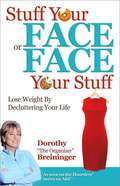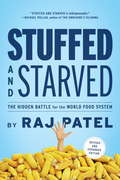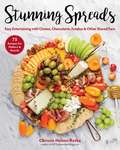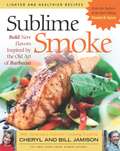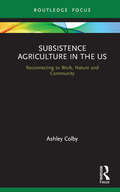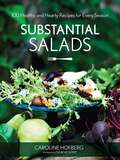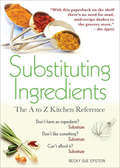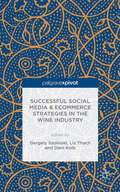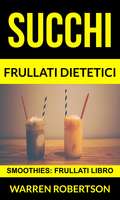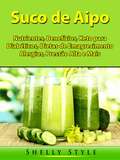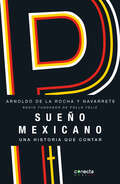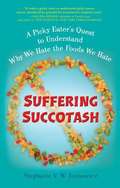- Table View
- List View
Stuff Your Face or Face Your Stuff: The Organized Approach to Lose Weight by Decluttering Your Life
by Dorothy BreiningerWhile organizing the lives of her many clients, Emmy-nominated organizing expert Dorothy Breininger learned to face her own stuff, and lost seventy-five pounds in the process. In this one-of-a-kind book she addresses weight loss from the much-needed perspective of what lies underneath our clutter—metaphorically, physically, and emotionally. Whether you're a packrat or a calorie-counter, a neat freak or a binge eater, Breininger reveals why, to be successful on the scale, you must first master the clutter within you and around you. With the same no-holds barred candor that resonates with TV viewers, she offers prescient advice to help anyone face their stuff, with an organized, step-by-step approach to either toss it, tame it, or tailor it to fit their lives. Filled with personal stories from clients, her own success story, and tips from fitness coaches and organizing experts, this imminently practical book gives everyone the tools to declutter their way to their dream size.
Stuffed and Starved
by Raj PatelCompletely updated and revised edition of one of the most widely-praised food books of recent years. It's a perverse fact of modern life: There are more starving people in the world than ever before, while there are also more people who are overweight. To find out how we got to this point and what we can do about it, Raj Patel launched a comprehensive investigation into the global food network. It took him from the colossal supermarkets of California to India's wrecked paddy-fields and Africa's bankrupt coffee farms, while along the way he ate genetically engineered soy beans and dodged flying objects in the protestor-packed streets of South Korea. What he found was shocking, from the false choices given us by supermarkets to a global epidemic of farmer suicides, and real reasons for famine in Asia and Africa. Yet he also found great cause for hope--in international resistance movements working to create a more democratic, sustainable and joyful food system. Going beyond ethical consumerism, Patel explains, from seed to store to plate, the steps to regain control of the global food economy, stop the exploitation of both farmers and consumers, and rebalance global sustenance.
Stuffed: (stuffed) (Orca Soundings)
by Eric WaltersCan Ian stand up for what he believes in? When Ian and his classmates watch a documentary about the health concerns of eating fast food, Ian decides to start a boycott and stop everyone he can from eating at Frankie's, a huge fast-food chain with a questionable menu. The boycott takes off and Frankie's gets concerned. The company's lawyers threaten Ian and his friends and try to force them to stop the boycott. Ian must convince others that the boycott is a good idea, but can he do it? The epub edition of this title is fully accessible.
Stuffed: The Sandwich Cookie Book
by Heather MubarakDouble the cookie, double the fun.Ice cream sandwiches, whoopie pies, macarons, homemade Oreos—this irresistible baking book has recipes for all these delicious sandwich cookies and plenty more. From Browned Butter Blondie blog creator Heather Mubarak, Stuffed features 65 mix-and-match cookie sandwiches for every occasion and craving, including both sweet and savory bakes that range from childhood classics with a twist (Nutter Butters! Chipwiches!) to sophisticated, party-ready treats (Strawberry Shortcake Macarons, Parmesan Polenta Crackers with Chive Cream Cheese). A whole chapter dedicated to swirly buttercreams, smooth ganache, fruity jams, and more lets you experiment with different cookie-filling pairings to your heart's content. Or leave out the filling altogether for a super simple bake—the possibilities are endless! Home bakers of all levels will appreciate the flexible, choose-your-own-adventure format, while fans of Snacking Cakes, Dessert Person, and 100 Cookies will delight in a new trove of crave-worthy recipes. In a chunky package with a puffy case and a photo of every cookie sandwich, this book is stuffed with all the cookie recipes you'll ever need.EVERYONE LOVES COOKIES! Cookies are easy to bake and they're delicious. They're the perfect weeknight activity/dessert, a top seller at bake sales, a holiday favorite, and an all-around crowd pleaser. This book offers 65 original recipes that feature not one, but TWO cookies apiece. More is more! GREAT VALUE: Stuffed offers great overall value: 65 cookie sandwich recipes with recommended fillings + more than 30 filling recipes (frostings, jams, ice creams, curds, ganaches) in a separate chapter = endless possibilities for variation. Home bakers can follow the recipe exactly, mix and match cookies and fillings, or skip the filling altogether. With more than 80 photos, including a photo of every cookie sandwich, Stuffed delivers a lot of delicious bang for your buck. BUZZWORTHY AUTHOR: Heather is the creator of Browned Butter Blondie, a popular baking blog whose Instagram was named by BuzzFeed as one of the "30 Best Instagram Food Accounts You Should Be Following" alongside Nik Sharma's, Smitten Kitchen's, Molly Yeh's, and others'. She's a serious, experienced baker known for delicious recipes and beautifully styled photos. Her first book reflects all of this: well-tested, indulgent bakes with tons of gorgeous visuals to feast your eyes on.UNIQUE OFFERING: Despite the numerous cookie recipe books on the market, the sandwich cookie angle has never been done before. Unique in its versatility, Stuffed makes an excellent gift for home bakers no matter how many baking books they already own—you can be sure they don't have anything like this!Perfect for:Cookie lovers of all agesHome bakers of all levels: recipes are accessible and flexible, allowing for experimentationFans of Dorie's Cookies, 100 Cookies, Snacking Cakes, Dessert Person, or Zoë Bakes CakesFollowers of the Browned Butter Blondie blog or Instagram accountShoppers looking for a fun birthday, hostess, or holiday gift alongside a baking utensil, apron, or bars of chocolate
Stunning Spreads: Easy Entertaining with Cheese, Charcuterie, Fondue & Other Shared Fare
by Chrissie Nelson RotkoOffer Your Guests a Variety of Bites and Flavors with Unique and Delicious Dips, Fondues, Boards, and More! From baby showers to birthday brunches, Stunning Spreads offers more than 75 approachable appetizers paired with a variety of simple, seasonal cocktails such as spiked hot apple cider and watermelon frosé that are sure to be the showstopper at your next gathering. To round out this fun, delicious fare is helpful hosting advice for preparing and serving everything from big boards to small bites. Beautiful and stress-free spreads fitting for any crowd include: Beer cheese fondueGrilled brie with blackberry balsamic glazeThe ultimate cheddar snack boardPimento cheese deviled eggsSummer grilled fruit and veggie boardRoasted garlic dipBourbon apple butterAnd so much more! Whether you&’re entertaining family for the holidays, having friends over to watch the big game, or cozying up on the couch with your loved ones, hosting at home doesn&’t have to be a hassle.
Stuzzichini: The Art of the Italian Snack
by Stef FerrariA FOOD & WINE BEST NEW BOOK Capture the magic of Italian happy hour with over 100 stunningly-photographed recipes for easy-to-make snacks and memorable sips. From the Tuscan countryside to Sicilian cafes, Italians enjoy their drinks with snacks called stuzzichini ("stoo-zih-ki-ni"). These small bites, skewers, dips, toasts, pastries and more are provided at no extra charge by the restaurant or bar and served alongside Negronis and Aperol Spritzes at aperitivo hour. Let this magical tradition of hospitality inspire your spread the next time you&’re tempted to assemble a cheese board for a gathering or put out a bowl of chips for a snack. Discover Stuzzichini in all of its many mouth-watering iterations: Crunchy bites from Sage & Brown Butter Popcorn to Farfalle Chips with Parmigiano Reggiano Cream Finger foods like Classic Tuscan Crepes with Ricotta and Honey and Prosciutto Cups with Melon and Burrata Filling Fried bites like Ascolana Style Fried Olives or Crab Fritters with Strega Citrus Vinaigrette and a mix of classic and new aperitivo cocktails, from the classic Americano, to a Hibiscus Ginger Spritz and, of course, the mysterious Negroni Sbagliato It's time to relax like an Italian. Stuzzichini is your guide to elevated snacking and recreating that sun-soaked piazza energy, chilled Spritz in hand!
Style and Spice: Over 200 Recipes from the American Southwest
by Larry Edwards“No doubt, author and chef Edwards knows his Southwestern foodstuffs" —Booklist Everything you love about Southwest cuisine, all in one cookbook! The American Southwest is synonymous with robust flavor and bright colors. Now you can bring the fiesta to your own casa! For the very first time in one single-volume cookbook, all aspects of southwest cooking have been gathered. Chef Larry Edwards presents an impressive assortment of recipes from salsas and barbecue sauces to enchiladas and ribs. Make your own condiments, recreate famous cocktails, and prepare regional entrees, salads, sides, and desserts. With over two hundred recipes, divided into four sections—the Southwest Pantry, Southwest Cantina, Southwest Kitchen, and Southwest Oven—there’s a dish for every occasion. Recipes include: Mango Jicama Salsa Sweet Pepper Salsa Spicy Mole Sauce Chipotle Mayo Baja Flank Ribs with Tequila and Honey Glaze Chicken with Cherry Salsa Santa Fe Chicken Wings Desert Chili Shrimp Whiskey Grilled Portobello Salad Baja Bread Pudding Southwest Candied Bacon Cactus Pear Sorbet Sangria Cobalt Margaritas With all these and more, we hope your guests bring a big appetite to your next dinner party, cookout, or picnic. Style and Spice has plenty to offer and is sure to bring a whole lot of flavor to your cooking!
Stylish Cakes
by Charlotte Neuville Michael CoffindafferMore than sixty unique couture confections that take the pastry arts to a whole new level of imagination, style, and tasteWith 250 full-color photographs and illustrations for French Chocolate Cake. The result is a rich compilation that reflects the unique sensibility of The Fashion Chef, and beautifully and stylishly documents the artistic process of a master.
Sublime Smoke
by Cheryl Alters Jamison Bill JamisonLighten up with fresh, flavorful dishes infused with all the smoky succulence of barbecue! For everyone who savors the husky resonance and deep flavors of wood-smoked barbecue, Sublime Smoke features more than 200 recipes that amptly demonstrate how creative and delicious smoke cooking can be. Cheryl and Bill Jamison are the pioneers of teaching home cooks how to prepare traditional American barbecue. In Sublime Smoke, the Jamisons expand the craft and refine the art by celebrating a world of ethnic and global influences and highlighting foods not typical of barbecue, such as chicken, fish, seafood, and vegetables. Sublime Smoke reveals both the versatility and the unbeatable goodness of smoke cooking. Recipes include:Double-Smoked SalsaGuadeloupe Conch FrittersWarm Smoked Trout and GreensTequila-Soused Beef BurritosMustard and Maple HamPomegranate Lamb ChopsJammin' Jerk ChickenTasty Satay TunaSaffron and Ginger Sweet PotatoesVeggie Heroes
Subsistence Agriculture in the US: Reconnecting to Work, Nature and Community (Routledge-SCORAI Studies in Sustainable Consumption)
by Ashley ColbyFocusing on ethnography and interviews with subsistence food producers, this book explores the resilience, innovation and creativity taking place in subsistence agriculture in America. To date, researchers interested in alternative food networks have often overlooked the somewhat hidden, unorganized population of household food producers. Subsistence Agriculture in the US fills this gap in the existing literature by examining the lived experiences of people taking part in subsistence food production. Over the course of the book, Colby draws on accounts from a broad and diverse network of people who are hunting, fishing, gardening, keeping livestock and gathering and looks in depth at the way in which these practical actions have transformed their relationship to labor and land. She also explores the broader implications of this pro-environmental activity for social change and sustainable futures. With a combination of rigorous academic investigation and engagement with pressing social issues, this book will be of great interest to scholars of sustainable consumption, environmental sociology and social movements.
Substantial Salads: 100 Healthy and Hearty Main Courses for Every Season
by Caroline HofbergSalads are often considered an appetizer or a summertime meal. When the weather is too hot, lightly tossed greens with seasonal fruits and veggies are perfect for cooling the body and filling the stomach. But with rich, filling ingredients and heartier flavors, salads can be served as main courses even in spring, autumn, and winter. Substantial Salads offers one hundred healthy and delicious recipes for green salads, whole-grain salads, and dressings. All are made with seasonal ingredients for fresh and cost-effective meals.Recipes include: Grilled asparagus with mozzarella Warm root vegetables with ham and gorgonzola Roast beef and bean salad with tapenade Halloumi potatoes with lamb kebabs Apple chicken salad Quinoa and oven-baked salmon salad And many moreTake advantage of the season's most wonderful ingredients, such as goat cheese, fresh berries, asparagus, wild mushrooms, melon, and fish. Each dish is easy to prepare and is perfect to serve as an entrée or as an accompaniment to other dishes. Be inspired by the time of year and craft fresh, delicious salads!
Substituting Ingredients: The A to Z Kitchen Reference
by Becky Sue EpsteinEveryone has been in this predicament: you're at home, with no time (or desire) for a trip to the store-but the recipe you're using calls for an ingredient you don't happen to have on hand. With this book, you'll have a solution: substitute. In Substituting Ingredients, author Becky Sue Epstein has collected more than 1,000 easy-to-find, healthy, and cheap substitutions. You'll find: Substitutions for difficult to find items and common items you may not have on hand, Green, nontoxic household cleaner solutions, Less expensive ingredient options, The best ways to measure fruits and vegetables for recipes, Simple recipes for condiments, sauces, marinades, and spice mixtures, and Strategies to remedy too much or too little of an ingredient.
Success in the Clean Bedroom: A Path to Optimal Health
by Natalie Golos William J. ReaForget the gloom and doom. Forget the panic. Forget the disasters, the toxic waste dumps, the sick building syndrome. Forget the bizarre interviews with people presented as freaks because they have environmentally triggered illness. The news media is filled with these. Concentrate on the SUCCESS STORIES. That's the thrust of "Success in the Clean Bedroom." This book can help you educate yourself and find answers about restoring and maintaining optimal health If you have environmental illness and don't know why, Success in the Clean Bedroom will provide many answers gently sprinkled with sensible but necessary precautions. The authors emphasize many unsuspected problems that perplex, bother, and incapacitate many adults who have been unsuccessfully seeking answers for years. They explain that it is no longer necessary to learn to live with many environmentally-related medical and emotional problems. Page after page of practical tips explain what you can do for yourself to figure out why you don't feel up to par and are unable to reach your full potential as a person, parent, or spouse.
Successful Slimming: How to choose the best diet for you to lose weight and keep it off for good (Wellbeing Quick Guides)
by Liz EarleLiz Earle explains the real science of slimming and shows you how to lose weight now and permanently retrain your eating habits.Bestselling beauty and wellbeing writer Liz Earle's fully revised and updated quick guide to successful slimming, including:- An insider's view on the diet industry and why most diets don't work- The best pros and cons guide to popular diet programmes- The golden rules of successful slimming that will work for YOU- How to cope with family meals and eating out- Handy calorie counters to help you keep track of your daily intake- The best exercises to boost your metabolism
Successful Social Media and Ecommerce Strategies in the Wine Industry
by Gergely Szolnoki Liz Thach Dani KolbSucchi - Deliziose ricette di succhi per principianti
by Stefania Pezzato Garry WilliamQuesta è una semplice guida all’estrazione di succhi che può essere usata per migliorare la propria salute, perdere peso o solo come fonte di nuove ricette di succhi per coloro che cercano nuove idee sul tema. Le spremute sono il modo più veloce per trasformare la vostra vita. Le ricette di succhi di frutta e verdura ricche di vitamine possono aiutarvi a perdere peso e migliorare la vostra salute dando impulso al vostro metabolismo e purificando il vostro corpo. Potete inserire le spremute nel vostro stile di vita o disintossicarvi con una dieta ricca di succhi. Qualunque sia il vostro scopo, questo libro è un’ottima guida per principianti; questo libro vi insegnerà cose nuove sulle spremute e i loro fantastici benefici per la salute. Scoprite uno dei primi passi per assumere il controllo della vostra vita e tornare in forma. Un ottimo modo per iniziare è bere succhi che vi facciano bene. Alcune ricette richiedono un frullatore, per assicurarvi la massima varietà e per poter aggiungere altri cibi salutari nella vostra dieta, cibi che un estrattore non può lavorare. Avete mai provato a spremere una banana? Non fatelo! Frullatela e basta. Il beneficio principale derivante dalle spremute è l’aumento del consumo di frutta e verdura. Viviano in una società di prodotti industriali e sembra difficile consumare cibi salutari, i succhi risolvono questo problema. Sommate spremute e uno stile di vita sano e avrete una salute di ferro e un corpo che amerete. Volete avere accesso a ricette di succhi deliziose, veloci e facili? Cosa state aspettando? Scaricate la vostra copia OGGI. Ci vediamo all’interno del libro, per iniziare! Scorrete verso l’alto e scaricate la vostra copia oggi! Agite oggi e fate la giusta scelta, quella di nutrire il vostro corpo con spremute fresche e gustose e vi garantisco che noterete un notevole miglioramento nella vostra salute, energia
Succhi: Frullati libro)
by Cecilia Metta Warren RobertsonL'utilizzo di frullati per poter perdere peso è più di una moda, poiché aiuta quando è fatto nel modo corretto. Farlo nel modo corretto è proprio quello che vi insegnerà questo libro. Ogni ingrediente è suddiviso in modo che possiate sapere esattamente il motivo per il quale può essere aggiunto al frullato e, presto, leggendo questo libro, sarete in grado di creare i vostri frullati. Le ricette di questi 25 frullati sono un modo straordinario per iniziare una dieta. Questo libro insegna anche come bilanciare i vostri frullati in modo che sappiate esattamente cosa state ingerendo e perché. Essendo tutti gli ingredienti bilanciati, sarete in grado di avere anche un equilibrio nel vostro corpo. Un corpo bilanciato significa che la perdita di peso è più semplice e questo libro è solo l'inizio.Queste ricette si adattano ai gusti di tutti: dagli amanti del caffè agli amanti del cioccolato; ogni ricetta è unica e divertente.
Succhi: ricette deliziose per tutti i gusti
by Cristina Ventrella Laura SandersPensi di non avere abbastanza tempo per preparare pasti e snack sani e deliziosi? Ti piacerebbe avere più energia, sentirti più felice e in forma ogni giorno? Vorresti avere un'abbondante scorta di ricette appetitose, facili e veloci a portata di mano? Se la risposta è sì, questo è il libro che fa per te! Gli estratti sono il modo più semplice e rapido per trasformare la vita di tutti i giorni. Queste ricette di estratti di frutta e verdura fresche e ricche di vitamine possono aiutarti a perdere peso, dare una marcia in più al tuo metabolismo e purificare l'organismo. ALL'INTERNO SPECIALI OMAGGI PER I NOSTRI LETTORI! Il vantaggio principale degli estratti è che consentono di mangiare più frutta e verdura. Nella società industriale in cui viviamo può essere difficile consumare cibo sano e gli estratti possono essere un valido aiuto. Combinateli con uno stile di vita sano ed avrete la chiave per una buona salute e un corpo invidiabile. CHE ASPETTATE, ACQUISTATE LA VOSTRA COPIA!
Suco de Aipo: Nutrientes, Benefícios, Keto para Diabéticos, Dietas de Emagrecimento, Alergias, Pressão Alta e Mais
by Hiddenstuff EntertainmentCure-se e seja mais saudável do que nunca consumindo suco de aipo! Você gostaria de poder eliminar alguma doença, desconforto, inflamação, dor ou depressão? Curiosamente, o suco de aipo é usado para tratar uma série de doenças há muito tempo! O emprego de técnicas naturais de cura ajuda a tratar doenças crônicas, assim como reduz inflamações, melhora o sistema imunológico, os níveis de energia e de concentração, o bem-estar geral e muito mais! Aqui estão os segredos usados por profissionais de terapias naturais para você se sentir muito mais saudável! Com técnicas testadas há décadas, este ebook traz a maneira mais rápida e eficaz para você se curar naturalmente bebendo suco de aipo e restaurar o seu bem-estar! Você vai aprender como aumentar a sua disposição em poucas semanas. E não é só isso, todos os aspectos da sua vida também vão melhorar. Quer saber como as pessoas tratam doenças e enfermidades crônicas? Você também pode aprender os segredos para alcançar este objetivo e sentir-se mais feliz e saudável. Este guia vai ensiná-lo técnicas comprovadas sem o uso de suplementos ou cursos caros. Ele inclui: - Remédios à base de suco de aipo. - Como eliminar doenças crônicas. - Como ter mais energia. - Como dormir melhor. - Como se livrar de enfermidades. - Nutrição. - O que você deve saber. + E MUITO MAIS! Se você quiser se sentir mais saudável, curar doenças ou melhorar sua concentração e bem-estar, este guia é para você. --> Volte para o topo da página e clique em “Adicionar ao Carrinho” para comprar instantaneamente Aviso Legal: Este autor e/ou proprietário(s) de direitos autorais não faz(em) nenhuma reivindicação, promessa ou garantia em relação à exatidão, integridade ou adequação do conteúdo deste livro e se isenta(m) expressamente da responsabilidade por erros e omissões nos conte
Sucos: Livro de Receitas de Sucos deliciosos
by Cátia Sofia Oliveira Fernandes Laura SandersAcha que não tem tempo suficiente para preparar refeições saudáveis, deliciosas e lanches? Gostaria de ter mais energia, ser mais feliz e sentir-se mais saudável a cada dia? Quer receitas deliciosas, rápidas e fáceis de preparar? Se das perguntas acima respondeu "Sim", então este livro é para si! Sumos é a maneira mais fácil e rápida de transformar sua vida. Receitas frescas, ricas em vitaminas e sumos de frutas que podem ajudá-la a perder peso e melhorar a sua saúde, aumentando assim o seu metabolismo e estará a fazer uma limpeza seu corpo. BÔNUS ESPECIAL PARA TODOS OS LEITORES! O principal benefício dos sumos, é o facto de estar a consumir mais frutas e legumes diariamente. Na sociedade actual, pode parecer difícil consumir alimentos saudáveis e os sumos vão ajudá-la. Adopte os sumos para um estilo de vida mais saudável e terá mais saúde e um corpo no qual se sentirá bem.
Sueño mexicano
by Arnoldo de la Rocha y Navarrete«EN LA VIDA HAY QUE TENER SUEÑOS LO SUFICIENTEMENTE REALISTAS PARA LLEGAR A ELLOS ANTES DE MORIR, PERO LO SUFICIENTEMENTE MOTIVANTES PARA LEVANTARSE TODOS LOS DÍAS A LUCHAR POR ELLOS.» Don Arnoldo de la Rocha es originario de la sierra de Chihuahua. Aprendió a trabajar la tierra desde los seis años, usó zapatos a partir de los ocho y entró a la escuela a los once. Forzada por la necesidad, su familia dejó el campo para instalarse en la ciudad. Luego de tocar fondo durante un turbulento periodo de adaptación al nuevo entorno, Arnoldo recibió una llamada que le cambiaría la vida: su tío lo invitaba a que aprendiera el oficio de asar pollos al carbón en su local para que después abriera su propia parrilla en otra ciudad. Desarraigado, inconforme, hambriento literal y figurativamente, soñador, Arnoldo tomó la oportunidad, aunque se resistía a abandonar los paradigmas con los que había crecido. Con el tiempo, descubrió su pasión por el negocio y, junto con sus socios, reunió los locales de la familia bajo la marca Pollo Feliz, la cual se volvería una exitosa cadena de restaurantes en México y el sur de Estados Unidos. El tercer libro de la colección Conecta México consiste en una historia de una familia que dejó el campo persiguiendo un sueño y lo cumplió tras una parrilla, que convirtió sus locales en un laboratorio de emprendedores y que finalmente alcanzó la prosperidad. Un camino cuesta arriba en todos los sentidos hacia la trascendencia que se acompaña de profundas reflexiones, enseñanzas de vida y consejos para los jóvenes emprendedores.
Suffering Succotash: A Picky Eater's Quest to Understand Why We Hate the Foods We Hate
by Stephanie V.W. LucianovicAs a child Stephanie Lucianovic lived for years on grilled cheese and created an elaborate system for disposing of revolting food involving bookshelves, holiday centerpieces, and, later, boyfriends. She agonized not over meeting her future in-laws, but over the peaches they served her. As an adult, this picky eater found herself in the most unlikely of circumstances: a graduate of culinary school who became a cheesemonger and then a food writer. Along the way, she realized just how common her plight was. It wasn’t surprising to discover that picky eating is an issue for millions of kids, but who knew there are even support groups for adults who can’t overcome it? Yet remarkably little is known about the science of picky eating, and cultural and historical questions abound. Are picky eaters destined to ascend to a higher plane of existence, and what happens when picky eaters fall in love or go to restaurants? How can you tell if you’re a “supertaster”? How does the gag reflex affect pickiness (and what secrets do sword swallowers impart to help overcome it)? Suffering Succotash is a wide-angle look into the world of picky eating, told by a writer who’s been in the culinary trenches. With wit and charm, through visits to laboratories specializing in genetic analysis, attempts to infiltrate the inner workings of a “feeding” clinic, and interviews with fellow picky eaters and adventurous foodies young and old, Stephanie explores her own food phobias and gets to the bottom of what repulses us about certain foods, what it really means to be a picky eater, and what we can do about it. .
Sugar Animal Cake Toppers: 5 easy to follow sugar animal designs
by Maisie ParrishA delightful sample from Character Cake Toppers, including a Mucky Pup; Daisy&’s Birthday; First-Class Meercat; Knit One, Purr One; and Panda Playtime. Learn how to make amazing fondant cake topper designs, with five fun ideas for sugar characters, bases and accessories. Whether it&’s a playful mummy panda with her mischievous cubs, or a kitten with a comfy cushion and a ball of yarn to play with, each cake topper design has three unique features for you to make—use these individually or mix and match from different designs to create your own unique cake toppers! Basic cake decorating techniques are explained with clear illustrated step-by-step instructions, so everyone can make fun cake toppers for birthdays, weddings and any occasion! From Maisie Parrish, author of the bestselling Fun & Original series! Sugar Animal Cake Toppers is excerpted from Maisie Parrish&’s fantastic Character Cake Toppers, with over sixty-five fun ideas for sugar characters, bases and accessories.
Sugar Baby
by Gesine Bullock-Prado Tina RuppCookbooks with recipes for baking with sugar (in the oven) continue to top the bestseller lists. And yet, no one has set out to do a cookbook with recipes on cooking with sugar (on the stovetop)--until now. In Sugar Baby, Gesine Bullock-Prado offers totally unintimidating step-by-step advice; the simplest instructions; recipes for candy, confections, and treats that integrate stovetop work into finished desserts; and a hilarious voice. Organized by temperature and chemical stages, here are more than 100 recipes for lollipops, caramel, rock candy, chocolate mousse, macarons, marshmallows, pudding pops, cakes, and much more. Sugar Baby will satisfy even the most demanding sweet tooth.
Sugar Baby Sampler
by Gesine Bullock-PradoA selection of Sugar Baby recipes to get you startedCookbooks with recipes for baking with sugar (in the oven) continue to top the bestseller lists. But until now, no one has set out to do a cookbook with recipes on cooking with sugar (on the stovetop). The Sugar Baby Sampler gives a taste of the full Sugar Baby cookbook, including three of Gesine Bullock-Prado&’s recipes for candy, confections, and treats. With the simplest instructions and the author&’s hilarious voice, the Sugar Baby Sampler offers a delicious selection of the one hundred recipes found in Sugar Baby, which will satisfy even the most demanding sweet tooth.
